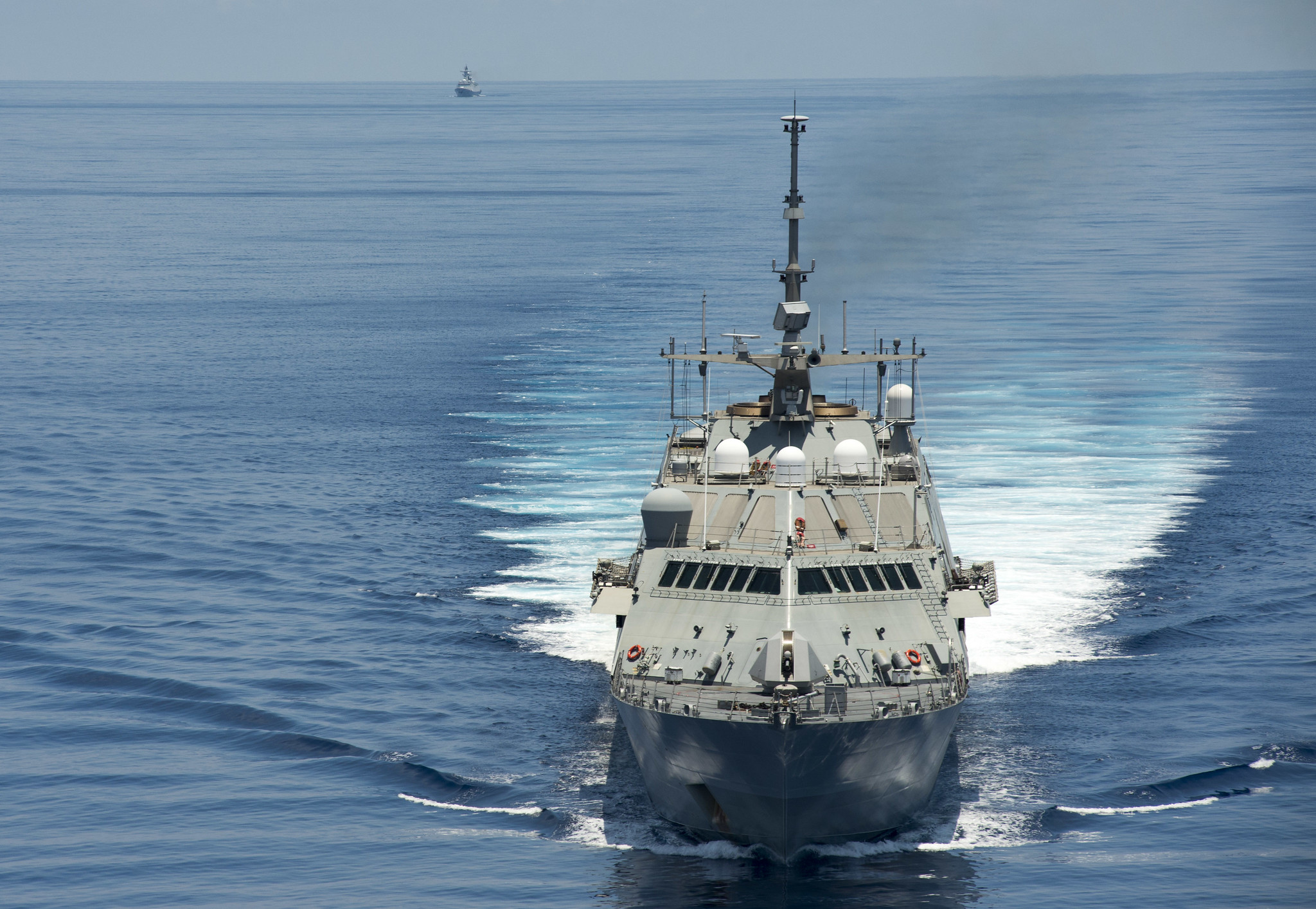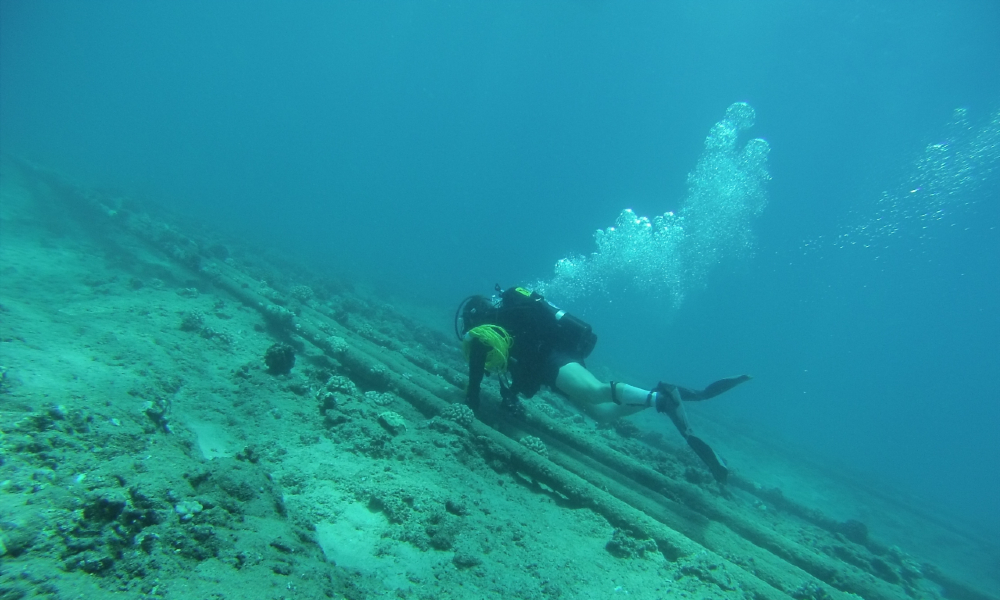Water Wars: Tense Relations Between China and the Philippines; Europe and Japan Seek Larger Roles in the Region
Relations between China and the Philippines continue to smolder; U.S. freedom of navigation operations continue; Japan and Europe move to address broader Indo-Pacific stability.

Published by The Lawfare Institute
in Cooperation With

Sino-Philippine Tensions
After April’s flare-up in tensions between China and the Philippines over the concentration of Chinese maritime militia vessels at Whitsun Reef (Mandarin: Niu’e Jiao; Tagalog: Julian Felipe Reef; Vietnamese: Đá Ba Đầu), Philippine President Rodrigo Duterte attempted to reduce tensions with China. Duterte, while insisting that the Philippines would not compromise on its sovereignty, said the Philippines owed China a “debt of gratitude” for free coronavirus vaccines that China provided to the Philippines and characterized China as a “good friend.”
Despite this more-conciliatory tone, tensions between the Philippines and China continued to rise through May. The Philippines began a series of coast guard exercises within its 200 nautical-mile exclusive economic zone (EEZ) in the South China Sea, despite warnings from China’s Foreign Ministry to “respect China's sovereignty and rights and interests, and stop actions complicating the situation and escalating disputes.” Of course, as described in earlier Water Wars columns, a 2016 United Nations Convention on the Law of the Sea (UNCLOS) arbitral tribunal rejected China’s “nine-dash line” claim to sovereignty over nearly the entire South China Sea. Instead, the tribunal ruled that “to the extent China had historic rights to resources in the waters of the South China Sea, such rights were extinguished to the extent they were incompatible with the exclusive economic zones provided for in the [UNCLOS] Convention.”
Additionally, despite dispersing from Whitsun Reef in April, hundreds of Chinese boats remained within or near the Philippines’ EEZ during May. According to some counts, over 200 vessels remained in the area, located mainly at Hughes Reef (Chinese: Dongmen Jiao; Vietnamese: Đá Tư Nghĩa; Philippines: McKennan Reef) and Gaven Reef (Mandarin: Nanxun Jiao; Vietnamese: Đá Ga Ven; Tagalog: Burgos), with a few still at Whitsun. Most observers agree that these vessels are likely the same Chinese Maritime Militia vessels that left Whitsun Reef last month. “Almost all of them are moored. They don’t move…Just like they were at Whitsun Reef,” said one geospatial intelligence firm executive. As late as mid-May, some 287 Chinese vessels remained in the South China Sea, the majority of which were within or near the Philippines’ EEZ.
In a profane, since-deleted tweet, Philippines’ Foreign Minister Teodoro Locsin expressed his country’s frustration at China’s behavior in the South China Sea: “China, my friend, how politely can I put it? Let me see… O…GET THE F—CK OUT. What are you doing to our friendship? You. Not us. We’re trying. You. You’re like an ugly oaf forcing your attentions on a handsome guy who wants to be a friend; not to father a Chinese province.” As a result of this public rebuke, and other blunt words from his defense minister, President Duterte “told his ministers…they must refrain from discussing the matter” of Chinese vessels within the Philippines’ EEZ. While this may “lessen tensions at the rhetorical level” and prevent mixed-messages between Duterte and his ministers, the Philippines’s Foreign Ministry still filed another diplomatic protest against the fishing ban China unilaterally imposed on the South China Sea, including areas within the Philippines’ EEZ, as well as the 287 vessels that the Philippines describes as “within the West Philippine Sea.”
In addition to diplomatic protests, the Philippines has begun planning “to convert a South China Sea island into a military hub amid rising tensions with China.” The hubm to be located at Thitu Island (Chinese: Zhongye Dao; Philippines: Pag-asa Island; Vietnamese: Đảo Thị Tứ) would be used to “sustain patrols in the South China Sea” as well as provide a base for “high-resolution, night-capable cameras to monitor activities around islands claimed by the Philippines.” In recent years, Thitu Island—located deep in the center of the South China Sea—has been the scene of a number of clashes between China and the Philippines. It is already the site of a few military installations, such as barracks and a communications tower, and has a few hundred resident civilians. While plans for Thitu are still in early stages, a well-developed military outpost in the heart of the South China Sea could be of future interest to the United States as well.
U.S. Freedom of Navigation Operation Sparks Sino-U.S. Debate
The U.S. military has increased its presence in the South China Sea as tensions rise in the region. In April, U.S. military aircraft conducted at least 65 aerial reconnaissance missions—a 40 percent increase compared to 2020, according to the Chinese Ministry of Defense—and continued to pursue freedom of navigation operations (FONOP). And the most recent FONOP in the Paracel Islands ignited a heated debate between the U.S. and China.
The Paracel Islands (Mandarin: Xīshā Qúndǎo; Vietnamese: Quần đảo Hoàng Sa) have long been claimed by China, as well as by Taiwan and Vietnam. All three claimants require either permission or advanced notification before foreign warships may enjoy the right to innocent passage, a requirement that is a violation of the U.N. Convention on the Law of the Sea.
On May 20, guided missile destroyer USS Curtis Wilbur (DDG 54) “asserted navigational rights and freedoms” within the vicinity of the Paracel Islands. It was the Navy’s third FONOP in the South China Sea this year. In an unusually lengthy statement, the Navy claimed the warship upheld the “rightful uses of the sea recognized by international law by challenging the unlawful restrictions on innocent passage imposed by China, Taiwan, and Vietnam” and challenged China’s claims to straight baselines enclosing the Paracel Islands. The U.S. has repeatedly argued that Article 7 of the Law of the Sea of Convention prevents continental states, such as China, from drawing baselines around dispersed island groups, a position upheld in the 2016 South China Sea arbitral ruling.
The People’s Liberation Army’s (PLA) Southern Theatre Command released a statement proclaiming that the USS Curtis Wilbur “illegally” entered Chinese territorial waters. In response to the incursion, Chinese forces mobilized, tracked the warship, and, according to them, “expelled it.” The U.S. Navy strongly refuted this allegation, stating the “USS Curtis Wilbur was not ‘expelled’ from any nation’s territory.”
On May 24, the PLA Navy reported a recent live-fire exercise in the South China Sea. According to Chinese Communist Party mouthpiece, Global Times, the exercise included dozens of Southern Theater Command Naval Aviation Force warplanes and rehearsed precision and saturation attacks. The exercise included JH-7 fighter bombers, which are frequently used in exercises above the Taiwan Strait. Although the drill was announced shortly after the USS Curtis Wilber’s FONOP, Chinese state-run media claimed the live-fire exercise was not a retaliatory response.
Japan Engages Allies to Stabilize Taiwan Strait
As Sino-Taiwanese tensions remain high, Japanese Prime Minister Yoshihide Suga is attempting to maintain maritime security through bilateral diplomacy and military posturing.
On April 16, Japan and the United States released a joint statement calling for “peace and stability across the Taiwan Strait.” The highly publicized announcement prompted a harsh Chinese response. According to the South China Morning Post, the PLA’s Eastern Theater Command conducted a “large-scale aerial bombardment exercise” in response to the US-Japanese statement. The live-fire exercise lasted nine hours and included dozens of H-6K strategic bombers.
Japan may have also conducted a joint surveillance operation with Taiwan. Satellite images from May 1 show Japanese and Taiwanese naval forces escorting the PLA frigate Binzhou through the Miyako Strait, a 70 mile stretch between Taiwan and the Japanese island of Yonaguni. Although officials from neither government have confirmed the suspected cooperation, Taipei’s Apple Daily described it as the “first joint surveillance operation between Taiwan and Japan.”
Suga’s recent actions, which he argues are to ensure maritime stability in the region, are strongly supported by Japanese public sentiment. A Nikkei survey found that 73 percent of Japanese citizens support their nation’s determination to maintain stability within the Taiwan Strait.
Europe’s Strategy in the Indo-Pacific Region
In April, the European Union adopted a strategy for the Indo-Pacific entitled “EU Strategy for cooperation in the Indo-Pacific.” In this new strategy, the EU member states “acknowledge the importance of a meaningful European naval presence in the Indo-Pacific,” though it remains unclear how many European navies actually possess the capacity to send warships to the region for significant deployments. Germany, for example, committed to send a single frigate through the South China Sea in August, but the EU’s strategy seeks to “forge new partnerships in the region to extend its reach.” The EU strategy also, in the words of one Politico article, “mirrors some of the U.S. strategic planning in the Indo-Pacific, especially on ‘free and open’ maritime supply routes, security and trade diversification.” Perhaps most significantly, the strategy document represents a “consensus reached by the 27 EU member states,” the result of lengthy debates and internal negotiations. Its points of emphasis, therefore, may be more noteworthy because they likely represent significant areas of agreement across the bloc.
In addition to the new strategy document, the EU took a sharper stance on China’s actions in the South China Sea. In a statement, an EU spokesperson specifically rejected “any unilateral actions that could undermine regional stability and the international rules-based order,” referencing the “the Arbitration Award rendered under UNCLOS on 12 July 2016” that China rejects and noting that “the recent presence of large Chinese vessels at Whitsun Reef, endanger[s] peace and stability in the region.” The Chinese Mission to the EU, meanwhile, rejected the EU’s position and reiterated its view that the 2016 UNCLOS arbitration is “null and void.” It also referenced Europe’s imperial history in China, declaring that “[t]he South China Sea should not become a tool for certain countries to contain and suppress China, still less a wrestling ground for major-power rivalry. China urges the EU side to respect the efforts of countries in the region in properly addressing differences and maintaining stability in the South China Sea, and stop sowing discord.”
While the EU navies may not be able to maintain a major presence in the Indo-Pacific, the United Kingdom’s largest carrier strike group since the Falklands War set sail on May 22 en route to the Indo-Pacific, for a trip that includes a planned transit in the South China Sea. This flotilla—including its new crown jewel, the HMS Queen Elizabeth aircraft carrier—is, according to UK Defense Secretary Ben Wallce, intended to showcase a “truly global Britain that steps forward to tackle the challenges of tomorrow, working hand-in-hand with our friends to defend our shared values and uphold the rules-based international order.” As part of its deployment, the carrier strike group will visit over 40 nations, including India, Japan, Kora and Singapore. Some commentators, noting that this strike group constitutes almost the entirety of Britain’s naval power, consider this deployment “a piece of diplomatic theatre, not a military strategy.” Still, it does represent an enormous investment in the Indo-Pacific by an erstwhile European power, and it reflects Europe’s growing attention to the region.
Analysis
The USS Curtis Wilber’s FONOP within the vicinity of the Paracel Islands is a core component of America’s strategy to maintain access to the South China Sea. President Biden has publicly supported FONOPs, most recently during a graduation commencement speech at the United States Coast Guard Academy. “Longstanding, basic maritime principles like freedom of navigation are a bedrock of a global economic and global security. When nations try to game the system or tip the rules in their favor, it throws everything off balance.” Biden further said, "it won't happen without us taking an active role to set the norms of conduct to shape them around democratic values, not those of autocrats.” USS Curtis Wilbur’s FONOP occurred just hours after that speech, leading commentators to conclude that President Biden’s “tough words” were “back[ed] up” by the action in the South China Sea.
In Asia Times, a Hong Kong-based newspaper with a pro-China bent, Richard Heydarian argues that “China can be excused for feeling encircled in the sea.” Citing Japan’s new defense aid package to the Philippines, the UK carrier strike group en route to Asia, the growing tensions with the Philippines and a number of diplomatic statements aimed at China’s actions in the South China Sea, the author argues that a “US-led multinational pushback against China” is underway and “promise[s] to rile China.”
In Fulcrum, Robert Sutter argues that “Washington’s sustained support for Manila amid the latter’s recent confrontation with China in the South China Sea has helped to offset negative perceptions of Uncle Sam in the region.” Cataloguing the close cooperation between Biden administration officials and those in the Philippines, Sutter notes that much of the cooperation between the two governments appears “at cross purposes with Duterte,” who often take a more friendly stance towards China. Sutter concludes that this “ambiguity” is likely to last the remainder of Duterte’s term (which ends in 2022), but he contends “that the Biden Administration’s steady and effective handling of troubled bilateral relationship with a long-standing ally should be credited as a ‘win’ in Washington’s bid to win friends and influence people in the region.”
Finally, in the Wall Street Journal opinion pages, Seth Cropsey, director of the Hudson Institute’s Center for American Seapower, argues that the “U.S. Navy is at sea, figuratively as well as literally.” Cropsey contends that “the fleet doesn’t have enough ships to meet global commitments,” especially in light of the challenge posed by China, whose naval forces he notes “would be a formidable foe.” Cropsey’s main concern is that the U.S. Navy has not produced a maritime strategy “about how to win a naval war against China,” which he argues is essential given China’s “straightforward strategy: Keep the U.S. Navy from using its formidable capabilities to support allies and disrupt the regional—and eventually global—hegemony that China’s rulers seek.” Without a coherent naval strategy, Cropsey maintains, secondary naval issues like budgets, fleet growth and manning questions are also adrift and cannot be effectively addressed.






